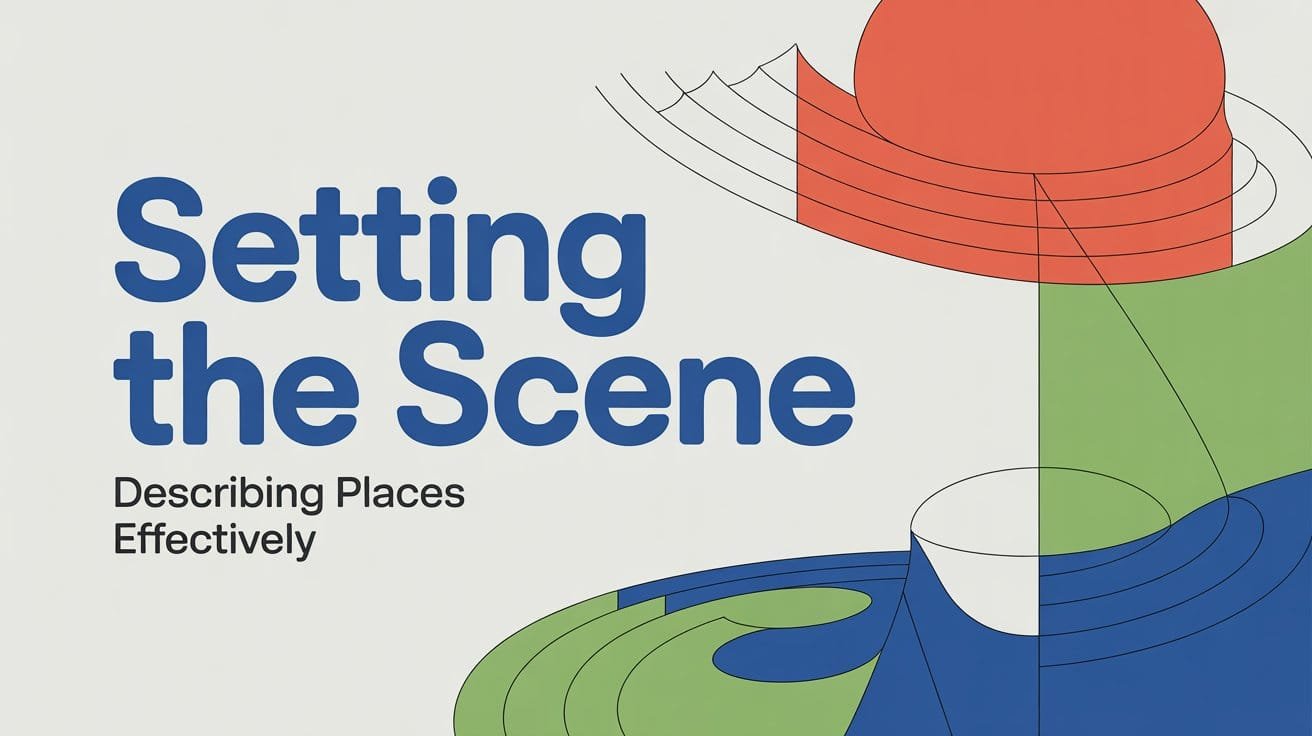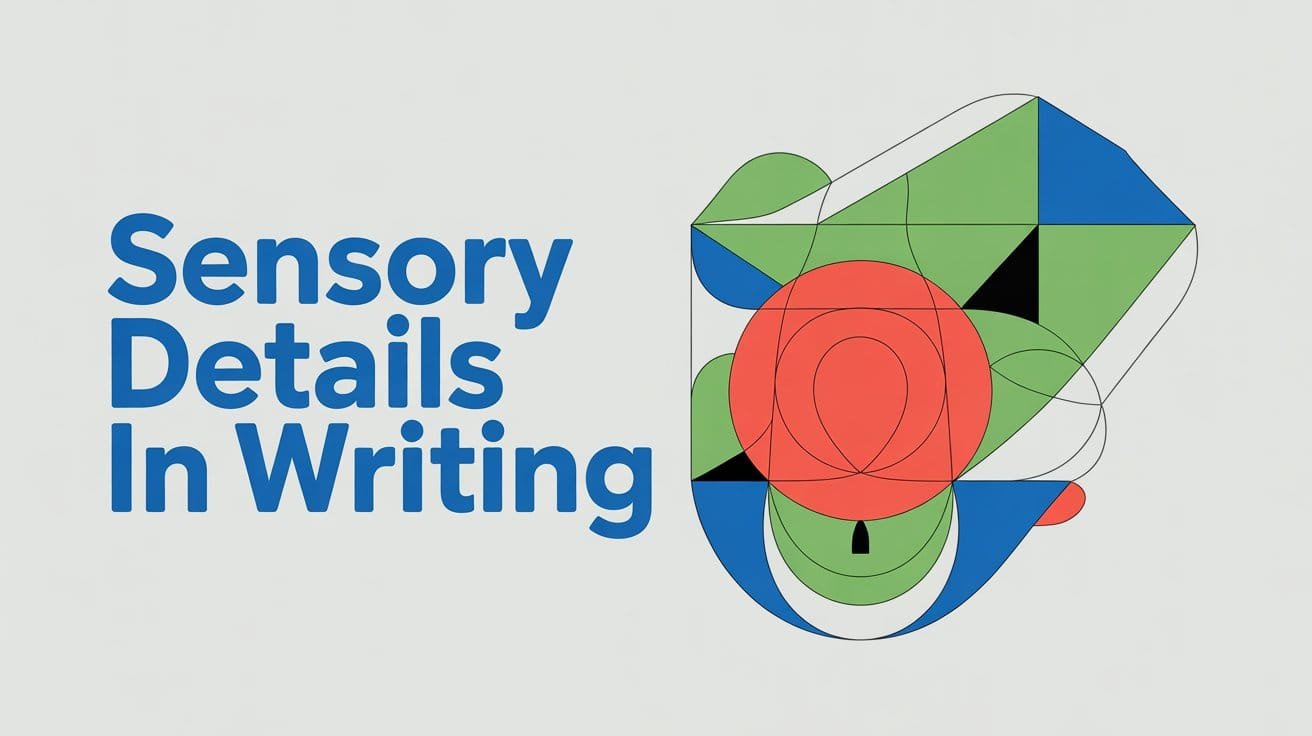A well-described setting can instantly draw readers into your writing. Whether you’re crafting a story, writing an essay, or working on a descriptive paragraph, the way you describe a place helps your audience picture the scene, feel the mood, and stay engaged.
But describing a place isn’t just about listing what’s there. It’s about choosing the right details, what you see, hear, smell, or feel and using them to build a vivid image that fits the purpose of your writing.
Why Is Setting Important in Writing?
In both fiction and nonfiction, the setting—or place where something happens—plays an important role. It gives your writing a sense of direction, mood, and context. A strong setting helps readers understand where the events take place and how the environment influences the people or actions in the scene.
Whether you’re describing a quiet village, a noisy classroom, or a crowded train station, the setting adds depth and realism to your writing.
Here’s why setting matters:
- It helps readers visualize the scene
Describing where things happen makes the writing feel more complete and believable. - It creates mood or atmosphere
A dark alley can feel tense. A sunny park can feel cheerful. The setting supports the emotional tone of the writing. - It gives context
Knowing the time, location, or surroundings can help the reader better understand the situation or characters.
Good writing doesn’t just tell what a place looks like—it helps the reader feel like they’re there.
How to Describe a Place in Writing
Writing about a place involves more than just naming what’s there. A strong description helps the reader visualize the scene and feel emotionally connected to it. The key is to include only the most relevant details—those that create a clear image and match the tone of your writing.
Here are four strategies to help you write vivid, effective place descriptions:
1. Use the Five Senses
To bring a scene to life, include more than just what the place looks like. Think about what someone would hear, smell, feel, or even taste if they were actually there. These sensory details allow your reader to fully imagine the setting, rather than just read about it.
Example: “The salty breeze stung my face as seagulls screeched above the crashing waves.”
Here, the sense of touch (breeze), sound (screeching seagulls), and smell/taste (salt) are all used to deepen the description.
2. Focus on Meaningful Details
Descriptive writing doesn’t mean describing everything. Instead, choose the specific features of the place that matter most—details that support the tone, mood, or purpose of your scene.
Example: “The flickering streetlamp cast long shadows on the empty road.”
This small detail adds to a quiet or eerie mood without overwhelming the reader with unnecessary information.
Tip: Think about what stands out in the setting—and what the reader needs to notice first.
3. Show the Place Through Action
Rather than listing what a place looks like, let it reveal itself through movement or activity. This technique keeps your writing natural and makes the setting feel more connected to the scene.
Example: “She brushed the dust off an old photo frame and looked around the quiet, sunlit room.”
This shows the place and what the character is doing, without stopping the flow of the writing.
This method is especially useful in storytelling, where setting and action often go hand in hand.
4. Use Direction and Movement
Help your reader understand how space is organized. Mentioning the position or layout of elements in the scene—such as “behind,” “to the left,” or “along the wall”—gives your reader a clear sense of space and movement.
Example: “To the left, a narrow path led into the dense forest.”
This gives the reader a visual cue, almost like a camera panning across a scene.
Describing space this way also helps guide the reader’s attention through the setting in a logical order.
Useful Vocabulary for Describing Places
Choosing the right words is key to writing clear and vivid place descriptions. The right vocabulary helps you create the mood, show the setting clearly, and guide the reader’s imagination. Below is a list of useful words and phrases you can use when describing places in writing, grouped by type of setting.
Words for Natural Places (Mountains, Forests, Beaches, etc.)
- dense forest, chirping insects, cool shade, muddy trail
- crashing waves, smooth pebbles, golden sand, salty air
- thick vines, mossy ground, dripping leaves, tangled roots
- snow-covered peaks, frozen streams, silent woods, crisp air
Words for Urban or City Settings
- blaring sirens, flashing signs, crowded sidewalks, buzzing neon
- smoky air, subway rumble, graffiti walls, tall shadows
- traffic jam, blinking billboards, open shopfronts, steaming vents
- impatient horns, street musicians, food carts, bright storefronts
Words for Indoor or Room Descriptions
- flickering lamp, patterned curtains, cold tile floor, cracked mirror
- folded blankets, ticking clock, hanging photographs, faint scent of soap
- quiet corners, slanted ceilings, empty shelves, soft armchair
- worn carpet, dusty books, squeaky door, open window
Words for Rural or Village Settings
- blooming gardens, narrow lanes, quiet streams, wooden barns
- stone houses, open fields, winding paths, morning mist
- grazing cattle, chirping birds, hand-painted signs, old bicycles
- firewood piles, clay pots, rustic kitchens, green hills
Words for Weather and Atmosphere
- icy breeze, dark clouds, heavy fog, frozen puddles
- steady drizzle, pale sky, damp ground, distant thunder
- cool morning air, golden glow, shifting clouds, light snowfall
- sudden gust, sticky heat, shimmering pavement, crackling leaves
Tips for Writing Vivid Place Descriptions
A vivid setting doesn’t just describe where something happens—it draws the reader into the scene. The tips below will help you write descriptions that are clear, engaging, and effective, whether you’re working on a short paragraph or a full story.
1. Be Specific and Intentional
Choose details that matter to the scene. Instead of listing everything, focus on what helps create mood, show contrast, or guide the reader’s attention.
Example: “Clothes were piled on the chair, books lay open on the floor, and crumbs were scattered across the desk” creates a more vivid image than “The room was messy.”
2. Match the Mood and Tone
Let the setting reflect the emotion or theme of the scene. A cheerful setting might include bright colors and fresh smells, while a tense one might focus on darkness, silence, or discomfort.
Example: “A warm breeze drifted through the open windows” sets a relaxed tone, while “A cold draft slipped under the door” feels more unsettling.
3. Use Sensory Language Wisely
As discussed earlier, sensory details help make a setting feel real. Just make sure they don’t overload the reader—use 2–3 well-placed sensory elements that match the scene.
Example: “She walked through a tunnel of trees, where the air smelled of pine, the ground crackled with dried leaves, and sunlight flickered through the branches above” brings a forest to life.
4. Use Figurative Language with Care
Similes, metaphors, and personification can strengthen your descriptions—but only when they fit naturally. Avoid using them just to sound poetic.
Example: “The sun peeked through the clouds like a shy child” adds a creative touch without distracting from the image.
5. Avoid Overloading with Detail
Too much description can slow down your writing. Make sure each sentence adds something useful—whether it builds the setting, shows action, or supports the mood.
Examples of Describing a Place in Writing
Let’s look at some clear paragraph examples that show how to describe a place using sensory detail, tone, and movement. These descriptions can help you craft settings for your short stories or narrative paragraphs.
A Small Town Morning
The sun peeked over the rooftops as the town slowly woke up. A dog barked in the distance, and the smell of fresh bread floated from the bakery on the corner. The streets were still quiet, except for the soft squeak of bicycle wheels and the rustling of newspapers being delivered.
Inside a School Library
The library was cool and quiet, filled with rows of tall bookshelves. Dust floated in the light coming through the windows, and the only sound was the soft turning of pages. A student sat at the corner table, scribbling notes as the smell of old paper filled the air.
A Rainy City Street
Cars splashed through puddles as people hurried past with umbrellas. Rain tapped steadily on the pavement, mixing with the buzz of traffic and the faint sound of music from a nearby café. The air smelled of wet concrete and coffee, and steam rose from manhole covers in little puffs.
Forest Trail at Sunset
The sky turned orange as the sun dipped behind the trees. Leaves crunched underfoot, and the scent of pine and damp earth hung in the air. A soft breeze moved through the branches, and birds chirped gently as they settled in for the night.
Frequently Asked Questions (FAQs)
What is a place description in writing?
A place description is a part of writing where you describe a location or setting using specific details. It helps readers visualize where the action takes place by showing what the place looks, sounds, smells, or feels like.
How do I start describing a place in a story?
Start by thinking about what the character would notice first. Use a mix of sensory details, focus on mood or tone, and describe the most important features that set the scene.
What are good words to use when describing places?
Words like quiet, crowded, breezy, foggy, cozy, and bright are useful, depending on the type of place. Try to include specific nouns, adjectives, and verbs that help create a strong image.
What is the difference between setting and description?
The setting is the place and time where something happens. A description is how you show that setting to the reader using detailed language and imagery.



